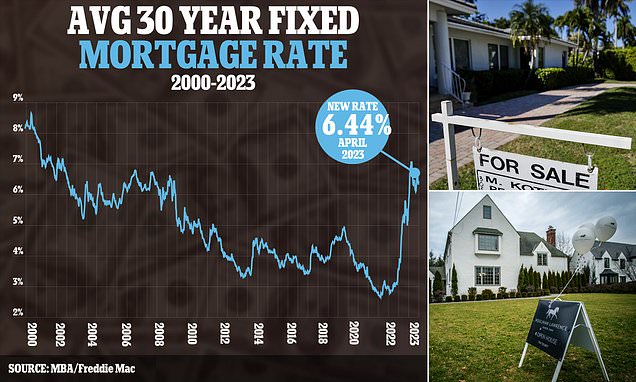
- Home prices have rebounded due to unexpectedly strong home sales at the beginning of the year, which ended a months-long decline
- Swing in market can be attributed to mortgage rate which have been fluctuating
- In February, home prices rose by 0.16% nationally with rising prices in 39 of the 50 largest U.S. markets; In Nov 2021, prices were falling in 48 of the 50 markets
House prices appear to be on the up once against following a dip in mortgage rates.
The average price of homes across the nation rose 0.16% in February. The increase came soon after mortgage rates began falling in December and January, filling homebuyers with renewed confidence in the housing market.
The sudden turnaround, with strong home sales at the start of this year, reverses a months-long decline in home prices.
Although the rise of 0.16% is small, it was the strongest one-month gain since May 2022.
When comparing the 50 largest markets across the U.S. 39 saw home prices rise in February.
Fifteen months earlier, in November 2021, prices were falling in 48 of the 50 biggest markets with the driving factor the wild swings in mortgage rates.
The average rate on a 30-year fixed mortgage began rising off of a record low at the start of 2022.
By June, it had increased from around 4% to just over 6%. Sales slowed down, and prices followed suit.
By last fall, the rate had shot over 7%, and home prices began cooling down more quickly.
In December and January, however, mortgage rates began to pull back, and homebuyers were quick to take advantage.
Last week, the average rate on 30-year fixed mortgages fell for the third straight week, to 6.32 percent, and is now hovering at 6.44 percent.
That’s higher than the average rate 12 months ago, which was 4.67 percent, but still marked relief for prospective homebuyers after a year of aggressive policy rate increases from the Federal Reserve in a bid to tame inflation.
Closed sales of existing homes in February, which represented contracts signed in December and January, increased remarkably by 14.5%, according to the National Association of Realtors, as buyers, sensing mortgage rates would soar, rushed to snap up properties.
It was the biggest monthly increase since July 2020, when city dwellers fled to greener pastures of the suburbs during the early days of the pandemic.
‘Conscious of changing mortgage rates, home buyers are taking advantage of any rate declines,’ says Lawrence Yun, NAR’s chief economist.
‘After nearly a year, the housing sector’s contraction is coming to an end. Existing-home sales, pending contracts and new-home construction pending contracts have turned the corner and climbed for the past three months,’ he added.
However, as with all real estate, the price dynamics differ depending on the location.
Miami continues to see the largest price gains, along with more affordable markets in the Midwest, such as Cincinnati, Columbus, Ohio, and Cleveland, according to Black Knight.
Meanwhile, prices are still falling in some of the markets that saw the greatest price inflation over the last several years, including Austin, Texas, Las Vegas, Salt Lake City, Seattle, and San Francisco.
As well, home prices are finally leveling off after surging to record highs last year. In February, the national median home price slipped 0.2 percent from a year ago, to $363,000, marking the first annual decline in 11 years, according to the National Association of Realtors.
‘Over the last several weeks, declining rates have brought borrowers back to the market but, as the spring homebuying season gets underway, low inventory remains a key challenge for prospective buyers,’ said Sam Khater, Freddie Mac´s chief economist.
Although mortgage rates were the driving factor for the price turnaround nationally, a limited supply of new homes is adding to the pressure.
According to Black Knight, the number of homes available for sale fell in February for the fifth straight month to the lowest level since May of last year.
New listings were also 27% lower compared to pre-pandemic levels.
‘While some price increases – most notably in Miami, which saw the largest of the month – can be chalked up to people moving to the area, we’re seeing stronger price gains more generally in those areas with better affordability and larger inventory deficits,’ says Andy Walden, Black Knight’s vice president of enterprise research strategy.






